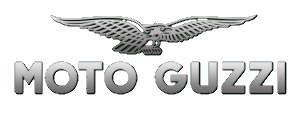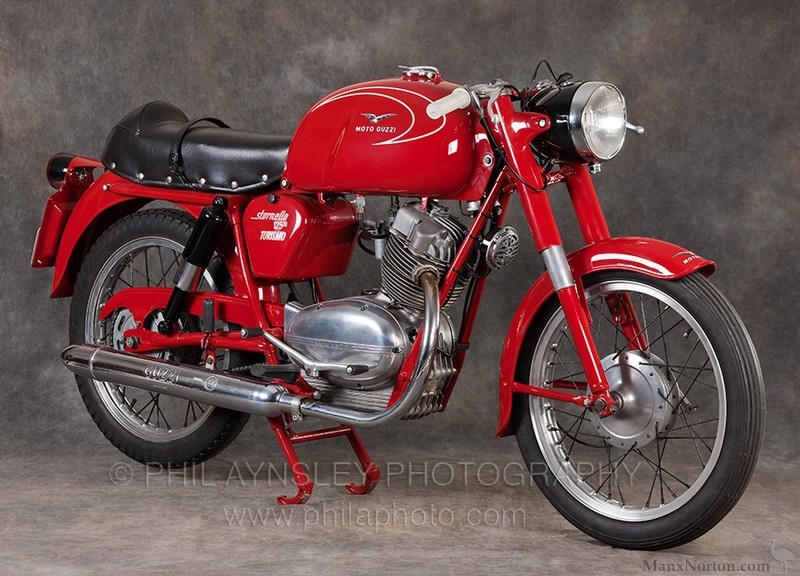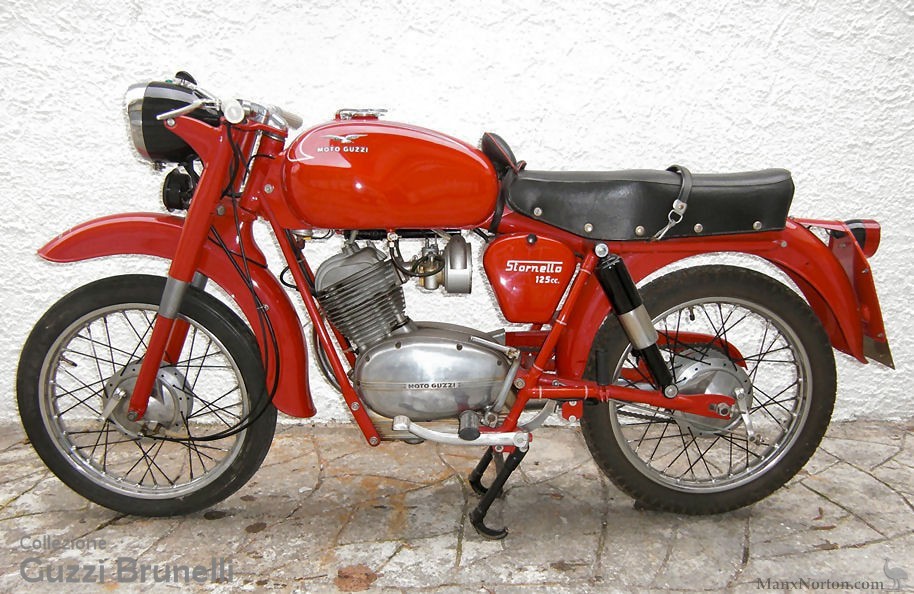



When Moto Guzzi, along with other motorcycle manufacturers, decided to abandon racing, Eng. Giulio Carcano, who had been the head of the racing department for many years, moved on to series production. Carcano was the designer of two Guzzi legends: the V8 racer, and later the V7 twin. In his new role his first project was the Stornello.
Presented at the Milan Fair in December 1959, Stornello sales began in 1960. At the time world's motorcycle industry was in deep crisis. Increased wealth was leading many people to abandon two-wheelers in favor of the automobile. The solution seemed to be to compete with the small car by producing cheaper motorcycle models.
The Stornello was designed to be economical, a motorcycle for commuting, easy to maintain and with an affordable purchase price. Economical to produce, economical to buy and maintain. Furthermore, the chosen displacement (125 cc) allows use even by sixteen-year-olds.
The Stornello was therefore presented with a displacement of 125 cc, and in 1968 the 160 cc version was introduced.
The cylinder is inclined forward 25° from the vertical. The engine has a bore of 52 mm and a stroke of 58 mm giving a total displacement of 123 cc, and with a compression ratio of 8:1 it develops a power of 7 hp at 7200 rpm.
The frame is an open double cradle, with the engine acting as a stressed member.
Lubrication is with oil in the crankcase (wet sump) and a gear pump, a novel solution of Guzzi which helped reduce production costs.
The fork is of the telehydraulic type, as is the rear suspension. The elements of the latter are particularly inclined so as to allow a wide excursion with a modest stroke.
The motorcycle is particularly light and, with its 7 HP, can reach 100 km/h.
Initially only the Turismo type was available. In 1961 the Sport model was introduced, with a modified engine that delivered 8.5 HP and allowed the bike to reach 110 km/h. The Sport model's engine had a hemispherical head, inclined valves, and a higher compression ratio (9.8:1 instead of 8:1). The carburetor was a UB20B, with the classic trumpet. The tank was larger and had a capacity of 14.5 instead of the 12.5 of the Turismo model.

In 1965 the new versions were released:
| Regolarità | derived from the machines used in competitions of this specialty |
| Sport America | very wide and high handlebars. Black silver or black and red |
| Scrambler America | off-road version |
The Regolarità version, as mentioned, is derived directly from the machines used by Moto Guzzi in some competitions of this specialty, in particular from the machines that had won the 1963 Six Days held in Czechoslovakia, where Italy won by mounting Lodola and Stornello. The Stornello present at these competitions had a Sport type engine. The larger 24 mm carburetor and the compression ratio brought to 11.3:1 allowed the engine to deliver 12 HP at 8000 rpm. The version put on the market had less powerful characteristics than those of the official racing bikes. The model was marketed only in 1966.
For the other models, it is more a question of variations in the trim and liveries than of truly new models.
The Scrambler America presents itself externally with some elements that are aspired to the Regularity type: raised muffler, high front mudguard, rear shock absorbers with exposed springs, while the tank is that of the touring model. The handlebar, high, has a transverse reinforcement bar. The two-seater saddle is of a new design. The ratios are slightly shorter.
The Sport America on the other hand, except for the saddle, is assembled using elements from previous models. The handlebars are high and the rear shock absorbers also in this model have visible chrome springs. The colors are new.
At the end of 1967 the new version was added with the 160cc engine obtained by bringing the bore to 58 mm. The piston is of new design, with three rings. The carburetor however remains the same, 20 mm. With a compression ratio of 9:1 and with 12.6 HP at 7500 rpm, the Stornello 160 was able to reach 118 km/h. The line was also new, especially in the colors, milk white with red stripes, the same livery as the V7 Sport, which came out in the same year. The line of the tank and that of the side panels were new, which now had the lock placed forward. In the style of the moment they had a more angular line, compared to the rounded one typical of the previous versions. The handlebars were now low, more sporty. The design of the mudguards was also new. The crankcase now features a bulge on the right side, which serves to house a 60 alternator. A 17 Ah battery is also associated. The front brake becomes more powerful and now has a diameter of 157 mm. It is produced, together with the 125, until 1971.
These were followed by the 5-speed models.
Engine: Single-cylinder, 4-stroke, inclined 25° forward, with overhead valves with rods and rocker arms. The engine is stressed, that is, it is a component of the frame. The cylinder is in light alloy, with a special cast iron liner; the head is also in light alloy and contains the valve control components in an oil bath; the combustion chamber is flat; the valve cover is large and fixed with six Allen screws. The piston is a Borgo flat-head and provides a compression ratio of 8:1, it is equipped with four elastic rings, two sealing rings at the top and two oil scrapers. In the Sport model the head is hemispherical and the compression ratio is 9.8:1. The stroke is 55 mm and the bore is 52 mm for a displacement of 123.175 cc. The power in the Turismo type is 7 HP at 7000 rpm and in the Sport type it is 8.5 HP. The fiscal power is 2 HP.
Ignition : with flywheel magneto alternator (6V - 28 W) made by CEV, with external high voltage coil. The manual specifies that "the vehicle must travel with the battery inserted; otherwise the rectifier would quickly fail". The spark plug is located on the front and easily accessible between the two tubes of the double cradle. For the Turismo type the recommended spark plug is the Marelli CW 225 L and for the Sport type the Marelli CW 260 L.
Distribution and valves : Turismo: model : parallel overhead controlled by rods and rocker arms. In the Sport model the valves are inclined.
Carburettor: a Dell'Orto ME18BS mounted on a long intake duct, with air filter and SF-1/7 type silencer, in a position slightly shifted to the left with respect to the longitudinal plane. In the Sport model the carburetor is the Dell'Orto UB20B, with horn.
Gearbox and transmission: the gearbox has 4 speeds and is controlled by a rocker arm on the right side . Clutch with multiple metal discs in oil bath, controlled by a lever on the handlebars. The primary transmission is, in the Guzzi tradition, with helical gears and the secondary with a chain. The gearbox gears are always in mesh with frontal clutches:
| 1st speed ratio | ..................... 1 : 3.04 |
| 2nd speed ratio | ..................... 1 : 1.81 |
| 3rd speed ratio | ..................... 1 : 1.29 |
| 4th speed ratio | ..................... 1 : 1 |
Brakes: expanding, in polished light alloy, diameter 135 mm; manual front, the rear is controlled by a pedal, located on the left side of the motorcycle.
Frame: tubular, open double cradle, closed at the bottom by the engine block. Wheelbase: 1,250 m; longitudinal dimensions: 1,900 m, transverse 0.6 m, vertical 0.95 m. Minimum ground clearance 0.16 m. Empty weight: Turismo 88 kg; Sport 92 kg.
Wheels: 17" x 2" 1/4 spoked rims. Tyres: 2 1/2 x 17" ribbed front, 2.75 - 17 R rear
Fuel Tank: in the Turismo type 12.5 litres, of which 2 are a reserve and in the Sport type 14.5 litres of which approx. 3 are a reserve. For the Turismo the petrol is Standard while for the Sport it is Super.
Electrical system and battery :: The flywheel magneto alternator is 6 Volts and delivers 28W. The diode rectifier is located in the front headlight, where there is also a key that is used to start the engine and to insert the entire electrical system. The headlight also houses the odometer. The key also functions as a light switch (city - country). The headlight is 130 mm in diameter and the switching between high and low beams is located, together with the horn button, on the handlebars. The headlights are supplied by the companies CEV and Aprilia. The rear light also contains the "STOP" controlled by a button on the brake pedal. The battery, 7 Ah and 6 Volts, is located under the saddle between the side panels.
Lubrication: forced with a gear pump, fixed in the lower part of the crankcase and controlled by a pair of helical gears. The oil tank is in the crankcase of the engine, which is divided into two halves vertically. The capacity is 1.5 l. The use of a single pump is a novelty for Guzzi. The recommended oil is SHELL X 100 SAE 30÷40, to be replaced every 2000 kilometers. At the same time the oil filter must be cleaned with gasoline. In the Sport type the tank contains 1.9 l and there are two filters: a mesh filter in the crankcase to be cleaned at each oil change and a centrifugal filter on the crankshaft
Suspension : front telescopic fork with hydraulic shock absorbers, rear swingarm with coil springs.
Exhaust: the header pipe exits at the front in a slightly shifted position to the right
Performance : The Turismo model develops 7 HP at 7000 rpm, while the Sport model develops 8.5 HP at 7000 rpm. The motorcycle overcomes slopes of approximately 31% with just one person. Fuel consumption (according to CUNA standards) is 2.3 litres per 100 km for the Turismo and 2.7 for the Sport . The maximum speed is 100 km/h for the Turismo model and 110 km/h for the Sport model. The maximum speed permitted in the various gears is:
| Turismo | Sport | |
| 1° marcia | 30.6 km/h | 33.0 km/h |
| 2° | 51.4 | 55 |
| 3° | 72 | 77 |
| 4° | 100 ca | 110 ca |
in first, second and third grade.
Identification : each motorcycle is distinguished by an identification number that is the same for the frame and engine.
The Stornello versions and chassis numbers:
| 1960-68 | Stornello 125 cc | |
| 1961-68 | Stornello Sport 125 cc | |
| 1966 | Stornello Regolarità 125 | |
| 1965-69 | 125 cc Scrambler | |
| 1965-69 | 125 Sport America | |
| 1968-69 | 160 cc (4 speed) |
The essential technical data:
| Model / Year | Stornello Turismo / 1960-68 |
| Motore | Four-stroke single-cylinder inclined: 52 x 58 mm / 123 cc |
| Compression ratio | 8:1 |
| Power | 7 CV a 7200 giri/min |
| Cylinder head | in light alloy with valves in oil baths |
| Cylinder | in light alloy with inserted barrel |
| Valve arrangement | in the head parallel |
| Valve control | pushrods and rocker arms. |
| Ignition | a volano magnete alternatore |
| Carburettor | Dell'Orto ME 18BS |
| Lubrication | oil in the crankcase and gear delivery pump |
| Clutch | multi-disc in oil bath |
| Gearchange | 4-speed constant-mesh gear shifter with foot control |
| Trasmission | primary with helical gears, secondary with chain |
| Chassis | double tubular cradle, engine is stressed member |
| Passo | 1250 mm |
| Front suspension | Teledraulic fork |
| Rear suspension | swingarm with hydraulic shock absorbers |
| Wheels | spoked with 17 x 2 1/4 rims |
| Tyres | 2.50 x 17" front; 2.75 x 17" rear |
| Brakes | internal expanding; front manual, rear pedal |
| Weight | 85 kg |
| Max speed | 100 km/h |
| Fuel consumption | (norme Cuna) 2,3 litri ogni 100 km |
| Tank capacity | 12.5 litres |
| Lubricant | 1.9 litres |
Sources:
If you have a query or information about Moto Guzzi motorcycles please contact us